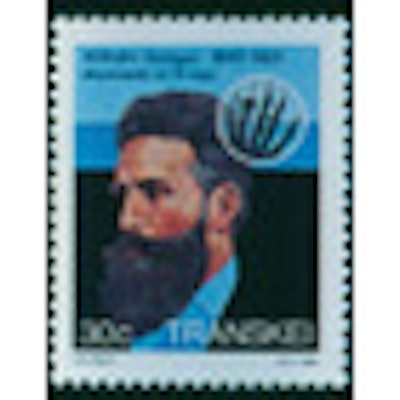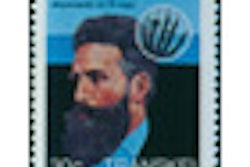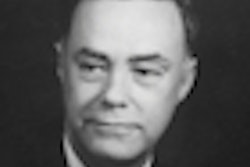
Most of the young doctors in the U.S. who opted to learn medical radiology in the early years of x-ray acquired their skills informally. However, this seat-of-your-pants training eventually gave way to the first recorded radiology residency program in 1915, which recruited doctors for one year of x-ray training and practice.
The program operated under the auspices of Dr. George Holmes, the acting radiology director at Massachusetts General Hospital (MGH) in Boston. The first resident was a Harvard medical graduate, Dr. Adelbert Merrill, who stayed in the department after his year of training.
The second resident was Dr. Sherwood Moore, who left MGH in 1917 to become a professor of radiology at Washington University in St. Louis. And in 1919, the third trainee, Dr. E. Denton McCarty, accepted a brief radiology appointment at the Peter Bent Brigham Hospital.
Each year, Holmes accepted another radiology trainee. In 1917, Merrill joined the MGH military medical unit and left Boston for France during World War I.
When the U.S. declared war against Germany in 1917, the Army recruited the academic medical military units. But few of those units had certified radiologists.
The Army medical corps had designated a self-adapted military radiologist, Dr. Arthur Christie, to gather and qualify doctors to manage Army hospitals. Christie made arrangements with academic radiologists in several medical schools to establish week-long training programs about diagnostic x-ray for inducted military doctors. A significant number of the military trainees chose to specialize in radiology when they were dismissed after the end of the war in early 1919.
While the histories of some U.S. academic radiology departments indicate their attraction of young physicians, few of them mention their ambition to create a program like Holmes' one-year training program at MGH.
By the 1920s, an increasing number of self-styled physicians were appointed and identified as radiologists in many hospitals. In most of the hospitals, the x-ray unit was assigned to the surgery, pathology, or internal medicine department. Some physicians, focused on obstetrics, tuberculosis, or orthopedics, relied upon the radiology branch to make images.
It was 1934 when representatives of five major radiology organizations gathered to accept Christie's recommendation of the establishment of an American Board of Radiology (ABR), soon to be the fifth medical specialty structure in the U.S. The concept of a specialty medical board was to design tests for physicians hoping to practice as defined medical specialists.
The new ABR had a leadership of 15 prominent radiologists who had been active in national societies, medical politics, and academic and other major radiology departments, and who concentrated on the growing dimension of radiology. Some teaching centers, like MGH, had accepted young doctors for a year or more of radiology training. While there still was no formal requirement for radiology residency experience, ABR chose to offer oral examinations for physicians who claimed to be experienced in x-ray technology and wanted to obtain accreditation.
The ABR leaders assigned three categories for their performance. The first was the several hundred leading radiology physicians recognized as academic or political. The second category was physicians who had practiced radiology for several years and who wanted to qualify for a specialty recognition. The third set was younger physicians who had experienced some formal training or apprenticeship in radiology practice groups.
The minutes of the ABR trustees indicate that they believed candidates should have some formal radiology training and come from hospitals that support the training, and that adequate facilities for an x-ray department should be defined. The trustees also discussed the value of medical schools allowing the briefing of medical students on the value and attractiveness of radiology in some form of training. ABR had coordinated its structure and implementation of examinations with structures defined by committees of the American Medical Association.
Still, from its founding in 1934 through the rest of the decade, ABR considered but did not define a structural radiology training course to be required for any applicant for candidate examination and ABR certification, nor did it define the qualifications of radiology training in the major 366 U.S. hospitals.
However, those issues were central to ABR efforts in 1940, when the board required hospitals and institutions making an initial application for approval for residency training to qualify for full three-year approval. No new residencies of one or two years' duration would be approved unless they were integrated with or contributory to a fully approved program. ABR also strongly recommended that all hospitals and institutions presently approved for residency training in radiology develop programs offering complete training, either intramurally or through affiliation, by June 1957.
Before and since adoption of that policy, ABR and committees of the American Medical Association have implemented requirements for the training of medical graduates. The four-year training program has been adopted for both diagnostic and therapeutic radiology, and the qualification of nuclear medicine is an ABR requirement.
Otha W. Linton, MSJ, retired in 1997 as the associate executive director of the American College of Radiology (ACR) after 35 years. He also served as executive director of Radiology Centennial in 1995. Mr. Linton holds a bachelor's degree in journalism from the University of Missouri and a Master of Science in journalism from the University of Wisconsin. His work has been published widely in the U.S. and abroad, and he is a regular contributor to several journals including Academic Radiology, the American Journal of Roentgenology, Radiology, and the Journal of the American College of Radiology. He joined the ACR staff in 1961 and had a key role in its growth. Over the years, his responsibilities with the ACR included government affairs, public relations, marketing, publishing, industrial liaison, and international relations. Just before his ACR retirement, he became the executive director of the International Society of Radiology and served in that role until earlier this year. Also, since his retirement, he has written and published 14 histories of radiology societies and academic centers.



















